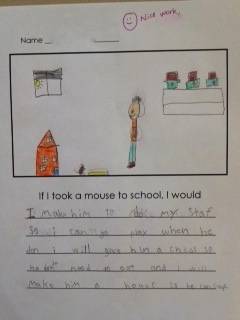I have been using the
Daily 5 this year, and so far I am loving it! My students are loving it, too! Some of them have even told me that they actually
like reading! :)
If you are unfamiliar with the Daily 5, it is a system that helps manage your literacy block. Students spend the first month building habits for working independently on reading and writing. That way, when you are conferencing with students and working with small groups, the other students know exactly what is expected of them, and they can work independently without interrupting your group time.
Setting up the Daily 5 takes about a month. We are about halfway through the setup, and have introduced Read to Self, Work on Writing, and Buddy Reading (Read to Someone). We still need to introduce Word Work and Listen to Reading.
As we introduce each new component of the Daily 5, we make a chart as a class, to help us remember behaviors for each component. The charts tell what the students' job is to do, and what my job as a teacher is to do.
Here are some of my anchor charts. If you have any questions about them, please ask! This is my first year doing Daily 5, but I can share my experiences and how I've made it work for my group of kids!
Here are the behavior expectations for Read to Self. We discuss these expectations before we practice, and also afterwards, to see if we met the expectations or if we can try harder next time.
We also talked about ways we can read a book. We can read the pictures, read the words, or retell the story using the words and pictures.
I really want my kids to focus on choosing "Good Fit Books" this year. For example, last week in the library, one of my students insisted on checking out Twilight, because she had seen the movie. I understand the connection, but that is definitely not a good fit book for a 3rd grader. To choose a "Good Fit Book", we use "I Pick"
I- I choose a book
P- Purpose (Why do I want to read it?)
I- Interest (Does it interest me?)
C- Comprehend (Do I understand what I read?)
K- Know (I know most of the words.)
These are some of the strategy cards the kids can refer to while they read. At the beginning of the year, I used a read-aloud to model each strategy. After practicing Read to Self, I check in with students to see if anyone used a strategy while they read.
After we had a good start with Read to Self, we started Work on Writing. I gave each student a notebook, and during Work on Writing, their job is to write about whatever they want. We brainstormed a list of topics, and I sent them on their way. Now, each day when we check-in, I give them the option of continuing what they started yesterday, or starting something new.
Now on to their favorite (and the most challenging to build stamina for)- Buddy Reading!
For Buddy Reading, students have to sit EEKK (Elbow to Elbow, Knee to Knee). There are three ways to Buddy Read:
Read 2 Different Books
Check for Understanding
I Read, You Read
(I can go into more detail with these in a later post. I introduced each one individually, and gave the students a day to practice each one. On the fourth day, I gave them a choice of which way they'd like to read with their buddy. It didn't go so well... so we started from the beginning and practiced each one individually before I let them try choosing again.)
My front whiteboard is where I keep all of my anchor charts. Once we start using Daily 5 independently, I will move these charts to free up my whiteboard space. But for now, this is like Daily 5 Headquarters.
I am hoping to put together a "Daily 5 Starter Kit" to help teachers who are new to the Daily 5 get started with all of the setup. Would anyone else find that helpful? If you have any questions about my anchor charts, please let me know!
Until next time,
-Miss Woodward























































